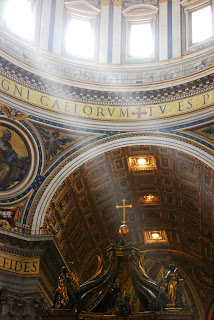Vatican is the smallest independent nation in the world. It is located within Rome, Italy and their land is demarcated by the wall; Vatican is a walled city. Needless to say, the country is the headquarters of the whole catholic churches in the world and one of the Christianity’s most sacred places. Politically, it is run by the pope; the vicar of Christ, and the majority of the country’s 800 people attend to the church’s service; priests, cardinals.
 Vatican’s official story tells us that St. Peter’s basilica, the large cathedral in the nation, was built right on St. Peter’s tomb. St. Peter, one of Jesus’ twelve students, was crucified upside down on Vatican Hill by a mandate from the Roman emperor of the time; Nero. Before his execution, St. Peter left a message; Upon this rock, I will build my church. The Roman Catholic Church considers St. Peter the first pope, and the basilica was built upon the crucified place on Vatican Hill hundred years later. An archaeological research was conducted and confirmed that twenty of mausoleums existed under the ground of the basilica (necropolis) and the church says one of the mausoleums is St. Peter’s, however the academic arguments have not reached a conclusion that St. Peter’s tomb really existed in the basilica’s necropolis.
Vatican’s official story tells us that St. Peter’s basilica, the large cathedral in the nation, was built right on St. Peter’s tomb. St. Peter, one of Jesus’ twelve students, was crucified upside down on Vatican Hill by a mandate from the Roman emperor of the time; Nero. Before his execution, St. Peter left a message; Upon this rock, I will build my church. The Roman Catholic Church considers St. Peter the first pope, and the basilica was built upon the crucified place on Vatican Hill hundred years later. An archaeological research was conducted and confirmed that twenty of mausoleums existed under the ground of the basilica (necropolis) and the church says one of the mausoleums is St. Peter’s, however the academic arguments have not reached a conclusion that St. Peter’s tomb really existed in the basilica’s necropolis.
People can visit the basilica upon payment of admission fee at 5 EUROS for stair-passage for the dome and 7 EUROS for lift using. Since the basilica attracts millions of people for its religious status and the historical/cultural bundling and decorations, people should stay in a long line waiting for the entrance. In my case, I had to wait for one hour only for its entrance. Even with the time-wasting waiting time, I personally think that it is worthy to wait; simply gorgeous in the cathedral. Decorations/pictures/sculptures…Everything in the basilica are by far more gorgeous than any other churches in the world as far as I know from my travel experience. As the headquarters of the whole Catholic Church, the basilica has a great sense of dignity.
In last March, a new pope called Francisco was elected after the former pope Benedicts 16th abdicated. His Holiness Pope Francisco is from Argentine and reportedly he prefers to live in a modest way. His characteristic seemed accepted positively from the world and I saw his picture books were sold very much in a souvenir shop inside the Vatican Wall. I am not a Christian and I did not buy the picture, but I somehow related myself to those who bought the pope’s picture. Like the Dalai Lama 14th in the Tibetan community, the pope is a beloved/endeared person by the believers. Personally, I expect his holiness to change the world in a positive way at a glance of the people’s great love to the pope in the souvenir shop.


コメント
コメントを投稿